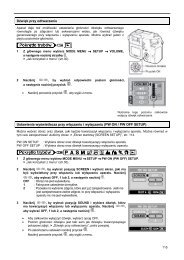Advanced Manual
Advanced Manual
Advanced Manual
Create successful ePaper yourself
Turn your PDF publications into a flip-book with our unique Google optimized e-Paper software.
Getting to know your camera better<br />
52 EN<br />
Taking stabilized pictures without the flash<br />
The flash is activated automatically when there is insufficient light, or when the camera is<br />
shaken. To take pictures with no flash in dark places, set the flash mode to [$] and set as<br />
follows:<br />
Increase the [ISO] setting<br />
g “ISO Changing the ISO sensitivity” (P. 22)<br />
The picture is too grainy<br />
There are several factors that can cause the picture to appear grainy.<br />
Using the digital zoom to take close-up pictures<br />
• With the digital zoom, part of the image is cropped and enlarged. The greater the<br />
magnification, the grainier the picture appears.<br />
g “DIGITAL ZOOM Zooming in on your subject” (P. 23)<br />
Increasing the ISO sensitivity<br />
• When you increase the [ISO] setting, “noise”, which appears as spots of unwanted color or<br />
unevenness in the color, can be introduced and give the picture a grainy appearance. This<br />
camera is equipped with a function to allow shooting at high sensitivity while suppressing<br />
noise; however, increasing the ISO sensitivity can result in some noise, depending on the<br />
shooting conditions.<br />
g “ISO Changing the ISO sensitivity” (P. 22)<br />
Taking pictures with the correct color<br />
• The reason why there are sometimes differences between the actual colors and the colors<br />
recorded in a picture is related to the light source illuminating the subject. [WB] is the<br />
function that helps the camera determine the true colors. Normally, the [AUTO] setting<br />
provides the optimal white balance, but depending on the subject, results may be better if<br />
you manually adjust the [WB] setting.<br />
• When the subject is in the shade on a sunny day<br />
• When the subject is illuminated by both natural light and indoor lighting, such as when<br />
near a window<br />
• When there is no white in the center of the frame<br />
g “WB Adjusting the color of a picture” (P. 22)<br />
Taking pictures of a white beach or snow scene<br />
• Take pictures with K in s mode. Suitable for taking pictures on a sunny day at the<br />
beach or in the snow.<br />
g “s (Scene) Selecting a scene mode according to the shooting situation” (P. 21)<br />
• Often, bright subjects (such as snow) turn out darker than their natural colors. Use 1F to<br />
adjust toward [+] to make these subjects closer to their true shades. Conversely, when you<br />
are shooting dark subjects, it can be effective to adjust toward the [–]. Sometimes, using the<br />
flash may not produce the brightness (exposure) that was intended.<br />
g “1F button Changing picture brightness” (P. 14)<br />
Taking pictures of a subject against backlight<br />
• With [ESP/n] set to [n], the picture can be taken based on the brightness at the center<br />
of the monitor without being affected by the light in the background.<br />
g “ESP/n Changing the area for measuring the brightness of a subject” (P. 23)<br />
• Set the flash to [#] to activate fill-in-flash. You can shoot a subject against backlight without<br />
the face of the subject appearing dark. [#] is effective for shooting against backlight and<br />
under fluorescent and other artificial lighting.<br />
g “3# button Flash shooting” (P. 15)
















